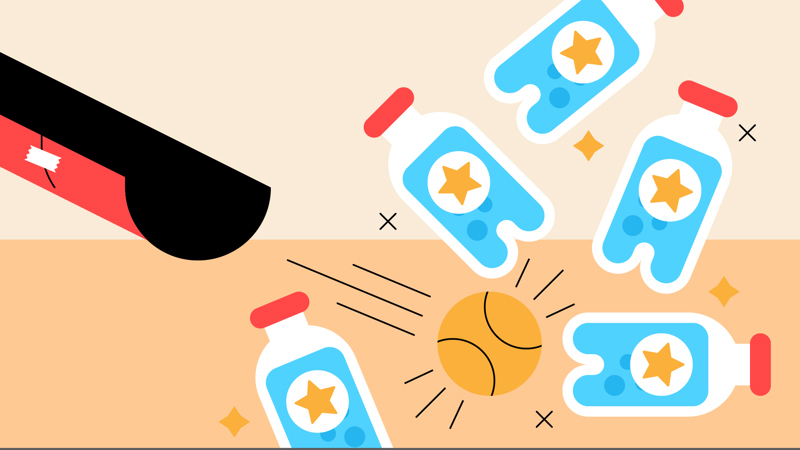
Rolling bowling
You’ll need
- Clean, empty plastic bottles (500ml)
- Clean, empty plastic bottles (two litres)
- Sticky tape
- A4 paper
- Tennis balls
Before you begin
- You could ask everyone to save plastic bottles at home, so you can gather enough for this activity.
- Use the larger (two litre) bottles to make the ramp. Cut the bottle in half lengthways to make two half pipe shapes. Stick bottle halves together to make a longer half-pipe shape.You could also use plastic guttering for the ramp. You could line the inside of the ramp with paper to make it smoother.
- Use the smaller (500ml) bottles to make the skittles. Fill them with a bit of water (or sand, or pebbles) so they don’t blow over at every draught.
- Each set needs one ramp and five skittles. It’s up to you how many sets you make.
Set up the bowling alley
- Everyone should use jumpers or rope to mark out a rough bowling alley (or more than one alley, if you have more than one set of skittles).
- Everyone should set out five skittles at the end of each bowling alley. They should put them in a line across the end of the alley, with a space between them.
- The person leading the activity should use rope (or masking tape) to mark a start line about four or five metres away from the skittles.
Get bowling
- Everyone should split into teams. There should be the same number of people in each team, if possible.
- Each team should choose a team name.
- The first team should stand by the bowling line. They should work together to set up the ramp—different people should take different roles, for example, holding the ramp, directing the ramp, releasing the ball, and collecting the ball.
- The team gets one point for each skittle they knock over. The person leading the game should give the team a set amount of time to score as many points as they can.
If the team has knocked down all five skittles, they should be reset so they can keep scoring until their time’s up.
- Each team should have the same amount of time to try and knock down the most skittles. The person leading the game should make sure that each team stays behind the bowling line, and can offer hints to the teams.
Tidy up
- Everyone should empty the skittles, and remove any sticky tape, paper, and decoration from the bottles.
- Everyone should recycle the (cleaned) plastic bottles and any paper.
Reflection
This activity was a chance to be a team player. Talk to your team, and think of one thing you found easy about working together, and one thing you found difficult. Once everyone’s ready, share your ideas with the other teams. Did people have similar answers? Sometimes teams have problems and they have to work together to solve them. What did you do to solve any problems? Would you do anything differently next time you work in a team? It can be tricky to work in a team, so well done for giving it a go!
This activity was also a chance for some people to be great leaders. Was anyone in your team a good leader? It can be tricky and confusing if everyone tries to lead the team at once—was it challenging to listen to someone giving directions? Why do you think teams have leaders?
Safety
All activities must be safely managed. You must complete a thorough risk assessment and take appropriate steps to reduce risk. Use the safety checklist to help you plan and risk assess your activity. Always get approval for the activity, and have suitable supervision and an InTouch process.
- Scissors
Supervise young people appropriately when they’re using scissors. Store all sharp objects securely, out of the reach of young people.
- Active games
The game area should be free of hazards. Explain the rules of the game clearly and have a clear way to communicate that the game must stop when needed. Take a look at our guidance on running active games safely.
- People could decorate the pins. They could also help stick the ramp together (but an adult should be the one to cut the bottles, before anyone else arrives).
- Experiment with different skittle set-ups—as people get used to it, you could use the traditional ‘V’ shape, or you could come up with your own.
- Move the bowling line closer or further way to change the challenge.
- You could also time how long it takes teams to knock over five skittles, rather than giving them a set time to knock over as many as possible.
Teams can stand or sit to set up their ramps and roll the balls.
All Scout activities should be inclusive and accessible.
Now you’ve made the ramps, see if you can use them for another fun challenge before you recycle the bottles. For example, you could use them to move water from one bucket to another—the winning team is the one with the most water in the second bucket. You could even poke holes in the ramps to make the game trickier (and wetter). This could count as an outside activity for the My Adventure Challenge Award or the Our Adventure Challenge Award.
Different people can take it in turns to lead the game, making sure everyone’s behind the line, keeping score, and offering hints to the team that’s playing.

